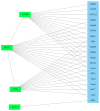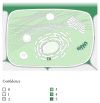Decreased Tissue COX5B Expression and Mitochondrial Dysfunction during Sepsis-Induced Kidney Injury in Rats
- PMID: 28246552
- PMCID: PMC5299166
- DOI: 10.1155/2017/8498510
Decreased Tissue COX5B Expression and Mitochondrial Dysfunction during Sepsis-Induced Kidney Injury in Rats
Abstract
Background. Sepsis is defined as a life-threatening organ dysfunction due to a dysregulated host response to infection. Sepsis is the dominant cause of acute kidney injury (AKI), accounting for nearly 50% of episodes of acute renal failure. Signaling cascades and pathways within the kidney are largely unknown and analysis of these molecular mechanisms may enhance knowledge on pathophysiology and possible therapeutic options. Material and Methods. 26 male Wistar rats were assigned to either a sham group (control, N = 6) or sepsis group (N = 20; cecal ligature and puncture model, 24 and 48 hours after CLP). Surviving rats (n = 12) were decapitated at 24 hours (early phase; n = 6) or 48 hours (late phase; n = 6) after CLP and kidneys removed for proteomic analysis. 2D-DIGE and DeCyder 2D software (t-test, P < 0.01) were used for analysis of significantly regulated protein spots. MALDI-TOF in combination with peptide mass fingerprinting (PMF) as well as Western Blot analysis was used for protein identification. Bioinformatic network analyses (STRING, GeneMania, and PCViz) were used to describe protein-protein interactions. Results. 12 spots were identified with significantly altered proteins (P < 0.01) in the three analyzed groups. Two spots could not be identified. Four different proteins were found significantly changed among the groups: major urinary protein (MUP5), cytochrome c oxidase subunit B (COX5b), myosin-6 (MYH6), and myosin-7 (MYH7). A significant correlation with the proteins was found for mitochondrial energy production and electron transport. Conclusions. COX5B could be a promising biomarker candidate since a significant association was found during experimental sepsis in the present study. For future research, COX5B should be evaluated as a biomarker in both human urine and serum to identify sepsis.
Conflict of interest statement
The authors declare no conflict of interests.
Figures








Similar articles
-
Identification of phosphorylated MYL12B as a potential plasma biomarker for septic acute kidney injury using a quantitative proteomic approach.Int J Clin Exp Pathol. 2015 Nov 1;8(11):14409-16. eCollection 2015. Int J Clin Exp Pathol. 2015. PMID: 26823757 Free PMC article.
-
Role of peroxynitrite in sepsis-induced acute kidney injury in an experimental model of sepsis in rats.Shock. 2012 Oct;38(4):403-10. doi: 10.1097/SHK.0b013e31826660f2. Shock. 2012. PMID: 22777123
-
Polydatin Inhibits Mitochondrial Dysfunction in the Renal Tubular Epithelial Cells of a Rat Model of Sepsis-Induced Acute Kidney Injury.Anesth Analg. 2015 Nov;121(5):1251-60. doi: 10.1213/ANE.0000000000000977. Anesth Analg. 2015. PMID: 26484460
-
Biomarkers as Beacons: Illuminating Sepsis-Associated Hepato-Renal Injury.Int J Mol Sci. 2025 May 18;26(10):4825. doi: 10.3390/ijms26104825. Int J Mol Sci. 2025. PMID: 40429966 Free PMC article. Review.
-
Proteomic approaches to the study of renal mitochondria.Biomed Pap Med Fac Univ Palacky Olomouc Czech Repub. 2016 Jun;160(2):173-82. doi: 10.5507/bp.2016.012. Epub 2016 Mar 17. Biomed Pap Med Fac Univ Palacky Olomouc Czech Repub. 2016. PMID: 26996242 Review.
Cited by
-
MicroRNA-191-5p diminished sepsis-induced acute kidney injury through targeting oxidative stress responsive 1 in rat models.Biosci Rep. 2019 Aug 13;39(8):BSR20190548. doi: 10.1042/BSR20190548. Print 2019 Aug 30. Biosci Rep. 2019. PMID: 31362998 Free PMC article.
-
Association between circulating mononuclear cell mitochondrial DNA copy number and in-hospital mortality in septic patients: A prospective observational study based on the Sepsis-3 definition.PLoS One. 2019 Feb 22;14(2):e0212808. doi: 10.1371/journal.pone.0212808. eCollection 2019. PLoS One. 2019. PMID: 30794688 Free PMC article. Clinical Trial.
-
CAV1 Protein Encapsulated in Mouse BMSC-Derived Extracellular Vesicles Alleviates Myocardial Fibrosis Following Myocardial Infarction by Blocking the TGF-β1/SMAD2/c-JUN Axis.J Cardiovasc Transl Res. 2024 Jun;17(3):523-539. doi: 10.1007/s12265-023-10472-9. Epub 2023 Dec 13. J Cardiovasc Transl Res. 2024. PMID: 38092988
-
Effect of miR-132-3p on sepsis-induced acute kidney injury in mice via regulating HAVCR1/KIM-1.Am J Transl Res. 2021 Jul 15;13(7):7794-7803. eCollection 2021. Am J Transl Res. 2021. PMID: 34377256 Free PMC article.
-
Multi-Omics Techniques Make it Possible to Analyze Sepsis-Associated Acute Kidney Injury Comprehensively.Front Immunol. 2022 Jul 7;13:905601. doi: 10.3389/fimmu.2022.905601. eCollection 2022. Front Immunol. 2022. PMID: 35874763 Free PMC article. Review.
References
MeSH terms
Substances
LinkOut - more resources
Full Text Sources
Other Literature Sources
Medical
Molecular Biology Databases
Miscellaneous

